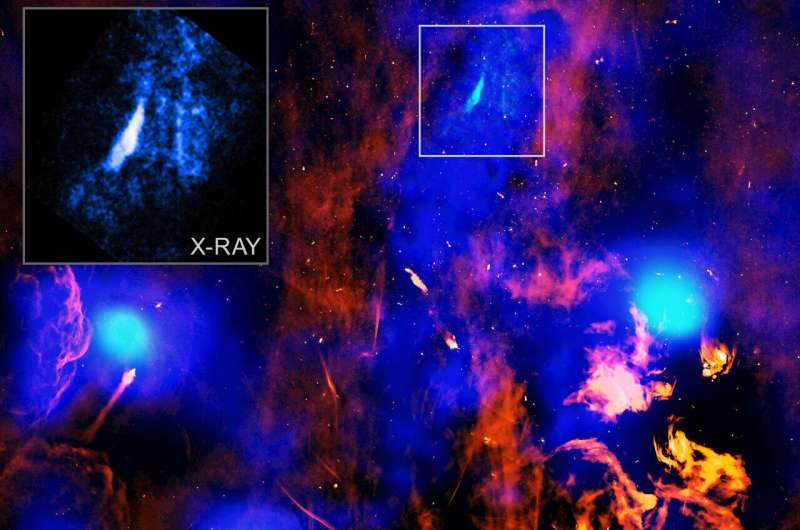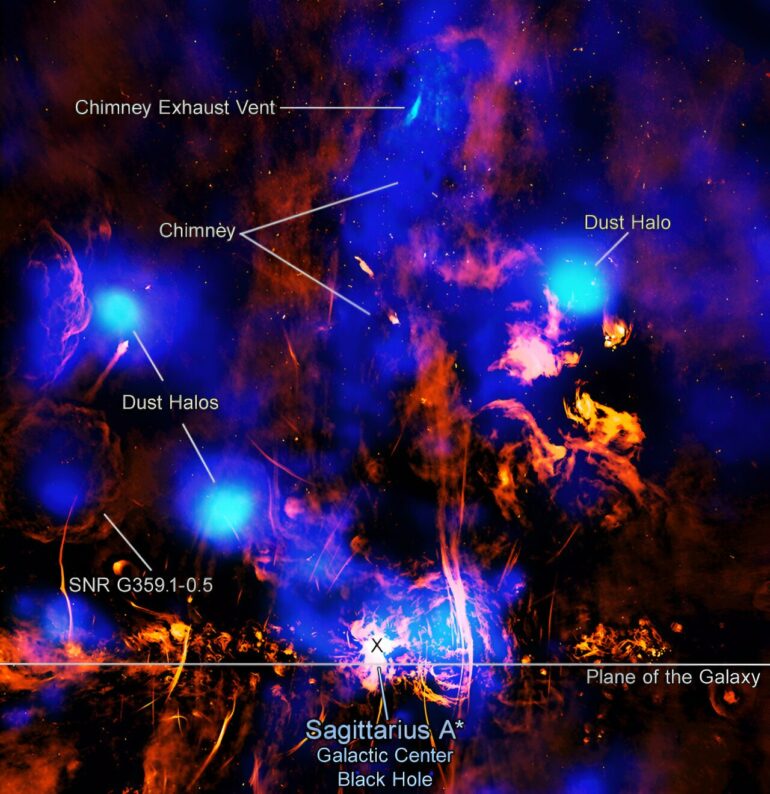Using NASA’s Chandra X-ray Observatory, astronomers have located an exhaust vent attached to a “chimney” of hot gas blowing away from the center of the Milky Way galaxy. Their paper describing these results is published in The Astrophysical Journal.
Eruptions from the supermassive black hole at the Milky Way’s center called Sagittarius A* (Sgr A* for short) may have created this chimney and exhaust vent.
The chimney and vent are about 26,000 light-years from Earth. The chimney begins at the center of the galaxy and stands perpendicular to the Milky Way’s spiral disk. Astronomers had previously identified the chimney using X-ray data from Chandra and XMM-Newton, an ESA (European Space Agency) mission with NASA contributions. Radio emission detected by the MeerKAT radio telescope shows the effect of magnetic fields enclosing the gas in the chimney.
The latest Chandra data reveals several X-ray ridges roughly perpendicular to the plane of the galaxy. Researchers think these are the walls of a tunnel, shaped like a cylinder, which helps funnel hot gas as it moves upwards along the chimney and away from the Galactic Center. The newly discovered vent is located near the top of the chimney about 700 light-years from the center of the galaxy.
“We suspected that magnetic fields are acting as the walls of the chimney and that hot gas is traveling up through them, like smoke,” said Scott Mackey of the University of Chicago, who led the study. “Now we’ve discovered an exhaust vent near the top of the chimney.”
The team thinks the exhaust vent formed when hot gas rising through the chimney struck cooler gas lying in its path. The brightness of the exhaust vent walls in X-rays is caused by shock waves—similar to sonic booms from supersonic planes—generated by this collision. The left side of the exhaust vent is likely particularly bright because the gas flowing upwards is striking the tunnel wall at a more direct angle and with more force than other regions.
The authors of the study think that the hot gas is most likely coming from a sequence of events involving material falling into Sgr A* and then eruptions from the black hole driving the gas upwards along the chimney, and out through the exhaust vent. However, they do not know exactly how often the black hole is being fed.
Previous studies have indicated that dramatic X-ray flares take place every few hundred years at or near the location of the central black hole, so those could play important roles in driving the hot gas upwards through the exhaust vent. Astronomers also estimate that the galactic black hole rips apart and swallows a star every 20,000 years or so. Such events would lead to powerful, explosive releases of energy, much of which would be destined to rise through the chimney vents.
“We’re not sure if this energy and heat are stoked by a large amount of material being dumped onto Sgr A* at once, like a bunch of logs being dumped on a fire,” said co-author Mark Morris of the University of California, Los Angeles. “Or it might come from multiple small loads being fed into the black hole similar to kindling being regularly tossed in.”

These images show evidence for an exhaust vent attached to a chimney releasing hot gas from a region around the supermassive black hole at the center of the Milky Way, as reported in our latest press release. In the main image of this graphic, X-rays from NASA’s Chandra X-ray Observatory (blue) have been combined with radio data from the MeerKAT telescope (red). Previously, astronomers had identified a “chimney” of hot gas near the galactic center using X-ray data from Chandra and ESA’s XMM-Newton. Radio emission detected by MeerKAT shows the effect of magnetic fields enclosing the gas in the chimney. The evidence for the exhaust vent is highlighted in the inset, which includes only Chandra data. Several X-ray ridges showing brighter X-rays appear in white, roughly perpendicular to the plane of the galaxy. Researchers think these are the walls of a tunnel, shaped like a cylinder, which helps funnel hot gas as it moves upwards along the chimney and away from the galactic center. © X-ray: NASA/CXC/Univ. of Chicago/S.C. Mackey et al.; Radio: NRF/SARAO/MeerKAT; Image Processing: NASA/CXC/SAO/N. Wolk
The particles and energy in the vent provide clues about the origin of two mysterious and much larger structures around the center of the Milky Way: the Fermi Bubbles seen in gamma-rays by NASA’s Fermi Gamma-ray Space Telescope and the eROSITA Bubbles, detected by ESA’s newest X-ray telescope. Both of these are pairs of structures extending thousands of light-years away from the center of the galaxy. They provide important information about past explosive activity near the center of the galaxy.
The Fermi and eROSITA bubbles are both aligned with the direction of the chimney and a second X-ray chimney that begins at the galaxy’s center and points in the opposite direction. The funneling effects of the exhaust vent near the top of the chimney may keep the hot gas focused as it travels upwards, aiding in the formation of the coherent structure of the bubbles.
“The origin of the Fermi Bubbles and the eROSITA bubbles are some of the biggest mysteries faced by studies of the high energy radiation from our galaxy,” said co-author Gabriele Ponti of the Italian National Institute of Astrophysics in Merate. “We’ve discovered a small structure that might play a large role in the creation of these gigantic bubbles.”
More information:
Scott C. Mackey et al, X-Rays from a Central “Exhaust Vent” of the Galactic Center Chimney, The Astrophysical Journal Letters (2024). DOI: 10.3847/2041-8213/ad3248
Provided by
Chandra X-ray Center
Citation:
NASA’s Chandra notices the galactic center is venting (2024, May 10)



